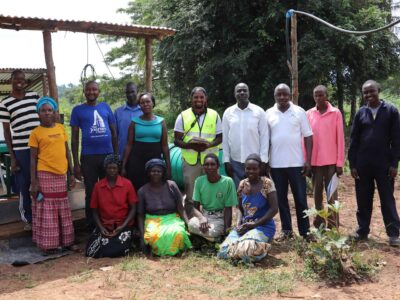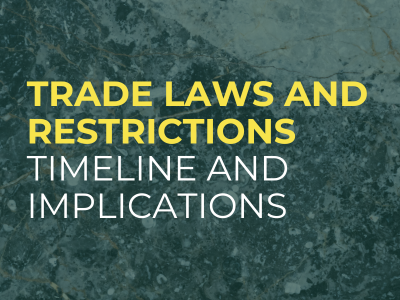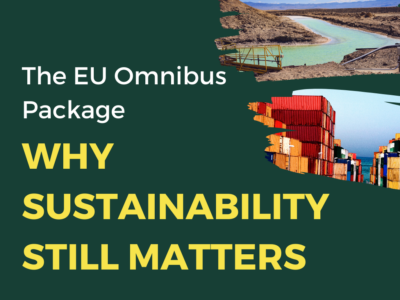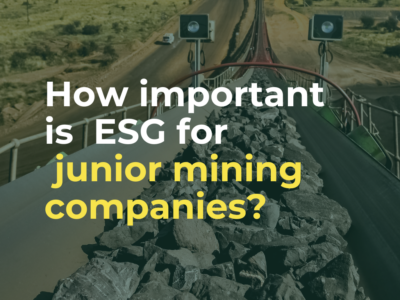
Building A Frontier Impact Investment Sector – The Path Forward For Artisanal And Small Scale Mining – Part 2
BY SARAH CAVEN
The artisanal and small-scale mining (ASM) sector is largely unknown or poorly understood by the finance world. There is a perception held by many that investing in and financing ASM comes with insurmountable risk. All investing carries risk, especially in new, unproven or complex sectors such as ASM, however, and this barrier is often dismantled over time as pilot projects demonstrate viability and the investment opportunity emerges. In this continuing series of blog articles, we consider the current status of ASM as an impact investment sector and the barriers it faces. We suggest that building the necessary infrastructure to enable access to finance for ASM can begin to erode these barriers and help to advance ASM projects nearer to unlocking finance.
TDI Sustainability and Solidaridad have partnered for this blog series, reflecting on insights gained from a recent research report commissioned by Solidaridad and carried out by the Global Initiative against Transnational Organized Crime; TDI’s research in this field, funded by planetGOLD (and supported by the Global Environment Facility); and TDI’s first-hand experience in building The Impact Facility for Sustainable Mining Communities, enabling blended finance solutions for ASM. In this blog, part two of three, we make the case that rather than focussing on barriers to finance we should focus on building the necessary infrastructure to enable access to finance for ASM based on experiences of the Impact Facility, the impact investment sector at large, and key findings that emerged from TDI’s research.
ENTERPRISE TO SECTOR LEVEL ACTION
In this blog we consider collective actions we can take to raise the profile of ASM as an impact investment opportunity.
Insights gained by taking an investor lens can be actioned at both a sector and enterprise level. By building the tools, services and investment products necessary, we enable future flows of impact capital and support progression of the ASM sector along the impact investment continuum.
We will consider:
Establishing investment-ready programs, including actions to proactively dismantle barriers to investment and building the necessary infrastructure to enable flows of impact capital to reach ASM
Seeking early-mover investors by segmenting the finance sector to maximise the effectiveness of fundraising efforts.
Repositioning ASM as a frontier opportunity to change the narrative around ASM at sector level away from one of barriers to one of opportunity.
ESTABLISHING INVESTMENT-READY ASM PROJECTS
As we know, any financial investment will take into consideration risk and reward. There are a range of perceived and real risks associated with ASM as outlined in our planetGOLD research, and by others. The Impact Facility, and others are using grant and donor finance to try and derisk ASM projects and boost their “investability”.
RISK VS REWARD – THE INVESTOR LENS
Impact investors consider opportunities based on a risk vs reward framework, types of risk forefront in impact investors’ minds are explored further in the GIIN 2019 Impact Investor Survey. Typically, high risk must be justified by high reward, but in ASM that high reward may not be immediately financial. To date, ASM has not demonstrated an attractive risk-reward profile and cannot easily compete with other more proven and accepted sectors such as agriculture or energy.
Based on our research we interpret risks associated with ASM to cluster around three key GIIN risk categories for impact investing. A key, and perhaps often overlooked, aspect is that of business model execution and management risk which is ranked with highest severity in GIIN’s recent investor survey.
Risk can be overcome however if a collective effort is made among donor programs and by social enterprises to build strong enterprises, measure and document impact metrics, trial investment-led approaches and manage and mitigate as many of the risks associated specifically with ASM as possible such as lack of licence tenure or presence of child labour.
BUILDING STRONG ENTERPRISES WHILE REDUCING RISK
Many mines have basic production methods unable to recover more than 50% of the ore. They work in often hazardous conditions, face unpredictable incomes and do not have clear business operational plans. Some limiting factors include seasonality, rendering mines dangerous or inaccessible during the rainy season, and geological unpredictability, resulting in expensive exploration phases yielding little or no results. Naturally, this generates a risk in the mind of an investor.
In order to maximise investability of ASM enterprises, TIF is striving to address the challenges that are first and foremost in the minds of artisanal miners – productivity and safety – in parallel with the ESG and mercury reduction goals of donors and investors.
TIF uses donor and grant money to work towards and trial investment-led rather than philanthropy-led solutions to ASM challenges with the aim of developing strong, responsible enterprises, that can build a track record and become investment-ready:
Productivity: TIF facilitates access to equipment that will improve productivity and safety in the mines through ‘lease to purchase’ schemes. This addresses miners’ more immediate concerns around economic stability and visible safety risks.
Processing: TIF also facilitates processing equipment to address mercury reduction and ultimately elimination through ‘lease to purchase’ or ‘pay per use’ processing hubs. This requires a greater degree of behaviour change in combination with sufficient ore volumes to make it economically viable, therefore this can be hard to do at an enterprise level.
Business skills: Lastly TIF is building training and services to support mines to develop better business and organisational skills with strong financial literacy, a basic understanding of the ore body and commitment to a continuous improvement plan. It should not be forgotten that foresight is also key, this requires a level of geological expertise as mines must be actively exploring, discovering and planning for their next high-grade ore zone.
The Impact Facility installing a mercury-free, gold processing hub on a pay per use scheme to encourage mining community buy-in in Uganda with local equipment provider, Borassus.
SEEKING EARLY-MOVER INVESTORS
Understanding the motivations of different types of impact investor will assist in the search for those more likely to invest now and, in the future if ASM matures over time as an impact investing sector. By understanding the investment continuum and the curve of adoption the bigger picture becomes more apparent as we see how access to finance can be expected to evolve over time. While ASM is a new impact investment opportunity, it could follow in the footsteps of other emergent sectors and eventually scale of opportunity that can be unlocked with the right approach.
Some impact investors simply don’t and never will like mining; it might even be explicitly ruled out by their investment mandate. This group is not likely to change its mind in the near term. Others are more open to new things such as the innovators or early adopters as discussed in the previous blog who are more likely to invest in ASM at this early stage in the sector’s development. Others might be intrigued by the investment opportunity but maybe waiting for clear proof of concept including evidence that return on investment and/or measurable impact is possible.
In summary, the curve of adoption shows that there are certain “types” of investor more likely to engage, the investment continuum shows there are different sources of finance more likely to engage. These two frameworks can be used as a guide to help focus the search for finance. More details can be found in the full planetGold report.
CHARACTERISTICS OF INNOVATORS AND EARLY ADOPTERS
Based on our research key motivations present in those who are likely to invest in ASM include one or more of the following; mission or impact-driven, seek a competitive advantage, willing to take more risk, are able to secure return on investment or believe they will in the long run.
Innovator and early adopter investors recognize the high-risk and (future) high-reward opportunity in ASGM, they are more entrepreneurial. They are willing to take the risk of being first movers in return for the reward of de-risking the sector, fulfilling a philanthropic or impact mission, or having a competitive or a long-term strategic advantage through the development of in-house ASM expertise ahead of the curve. Some may consider a significant part of the return on investment to be the generation of impact not only at an enterprise level but also a sector level (which we will discuss in more detail below).
While it may be more likely for us to find these opportunities in the impact investor sector where the investment mandate includes opportunities for high-risk projects targeting capital preservation or below market rates of return we should remember that even traditionally risk averse sources of finance such as domestic banks can and have engaged in ASM with the right support.
Next, we look at some themes that could help raise awareness of the impact investing opportunity in ASM.
REPOSITIONING THE ASM SECTOR
According to GIIN, less than 20% of assets under management are located in Sub Saharan Africa and South Asia. Opening up ASM as an impact investment sector could help distribute impact capital more equitably on a global scale!
To do this we need to create awareness and understanding of the ASM sector among the impact investor community. We consider some themes below that may resonate with investors.
MINING IS A REALITY OF OUR SOCIETY – SUPPLY AND DEMAND
There is growing realization that mining is an inevitable reality if we are to meet ever growing demand for commodities. At the same time, we face the reality that as consumer behaviour, policy and regulation change, demand is also rising specifically for more responsibly mined materials
Technological innovation can drive new and sudden demand for previously disregarded commodities, such as coltan. ASM is often fast to respond, establishing itself as an important part of the supply chain.
Other commodities have a long and expert tradition built upon hundreds or even thousands of years, such as coloured gemstone mining. If society consumes such luxury items as coloured gemstones, why not support the small mining communities that produce over 80% of these stones?
Mining will continue to be important for providing raw materials for new technologies, including green infrastructure. Impact investors are willing to invest in a solar or wind farm, but not in the mines that contribute the raw materials for these products. This is reflective of the disconnect in the minds of many of the important role mining plays in society. Even when impact investors are interested to invest in ASM they may perceive a lack of investment-ready opportunities and so it is up to the social ventures and development community to address this as we outline above. Ultimately, however, these are revenue generating enterprises with the potential to unlock impact in rural communities sought by impact investors.
MINING CAN BE IMPACTFUL – A “DO NOT ENGAGE” APPROACH IS A MISSED OPPORTUNITY
Artisanal and small scale mining provides a livelihood for marginalized communities with few alternatives. Indeed, when investors previously unfamiliar with ASM begin to understand the sector, there is often a realization that this is simply a producer sector with the potential to be impactful, like many others.
Some impact investors recognise ASM is undiscovered but one with significant impact potential for rural livelihoods. Some indicate that the main barrier to investing is the newness of this sector and consequent lack of internal sector expertise. This can only be overcome if more investors engage and we build the necessary market infrastructure to enable flows of finance.
We need to communicate the net impact of engaging with ASM to the impact investing sector. Not only can we create a positive impact, but we can eliminate negative impacts that otherwise go unchecked. However, as noted by many curious impact investors, there is a lack of available evidence of measurable impact in the ASM sector. A crucial step in repositioning ASM as a frontier impact investing opportunity is to better leverage grant funding to measure and communicate tangible impacts that can be achieved through investing in ASM.
ENTERPRISE VS SECTOR-LEVEL IMPACT – THERE IS A BIGGER IMPACT PICTURE
Often when we think of impact we focus on the impact at the enterprise level: how many kilograms of mercury are reduced, how many additional tonnes of ore will be produced, how many jobs created etc. One factor that is often overlooked, and not just in ASM, is sector-level impact. Those who are early to engage with a new impact investing sector generate impact at the sector level by helping to fund the building of market infrastructure, gathering data and delivering proof of concept that enables other, less risk tolerant investors to engage and thereby enabling greater flows of impact capital to reach marginalized communities at a sector level.
CONVERTING INTEREST INTO ACTION – INVESTMENT-READY PROGRAMS
Even if we make the case that ASM is an attractive frontier impact investment sector we need to supply investable opportunities to those who are interested in investing. The Impact Facility (TIF) is There are many social ventures and donor programs already well established in the sector, working in partnership with others to be part of the solution by building and refining the tools, knowledge, services and investment products to enable deal flow between the ASM sector and impact investors. All have a role to play in supporting the building the necessary market infrastructure to enable ASM to progress along the investment continuum and increase the flow and distribution of impact investment to ASM.
FOCUSING ON THE PATH FORWARD
If we are to see change, we need a collective effort between:
Donor and grant makers to embed economically viable enterprises as a core outcome, including the transition of these enterprises to commercial finance, sustaining growth beyond the life of donor or grant funding,
ASM development NGOs to use grant and donor finance to ensure outcomes that build viable ASM enterprises with the best chance of graduating to impact investment or becoming economically self-sufficient,
Impact investors and professional groups to consider ASM as a producer sector, not only critical in the supply of many materials essential to the modern world but also a globally significant provider of rural livelihoods,
Social venture and social finance intermediaries who can channel flows of impact capital to ASM enterprise or clusters of enterprises,
Governments to provide mining law that includes responsible ASM businesses,
ASM enterprises committed to strive for continuous improvement.
Together we can dispel overly generalized perceptions of ASM, dismantle barriers to investment by building the necessary market infrastructure and responsible ASM enterprises as a viable, frontier, investment and impact opportunity.
JOINT COOPERATION TOWARDS RESPONSIBLE ASMF
The Impact Facility is building an ecosystem for change. At its heart is the design of blended finance solutions for ASM with the vision to scale across geographies and commodities. It works with ASM groups, donors, NGO and private sector partners and investors. To date, the Impact Facility has trialled ‘pay per use’ and ‘lease to purchase’ asset financing in East Africa, alongside capacity strengthening programs in gold, cobalt and gemstones, working with market partners to build solutions that will enable sustained change among artisanal and small scale mining communities while growing global supply of responsibly sourced minerals.
This blog is based on the experiences of the Impact Facility and TDI’s research “Unlocking Finance for ASGM” funded by planetGOLD. Please get in touch with any thoughts or feedback on this blog or, if you would like to learn more about the Impact Facility and ASM.
In our next blog, we take a deeper dive into some of our action-oriented experiences detailing our pilot investment led approaches for gold mines across The Impact Facility’s portfolio in Tanzania, Kenya and Uganda, including the challenges and successes as we trial ‘pay per use’ and ‘lease to purchase’ schemes.
ADDITIONAL READING:
Read TDI’s planetGold funded research paper.
Find out more about the work of The Impact Facility.
Read about the Solidaridad gold programme.
Find out more about planetGOLD.



